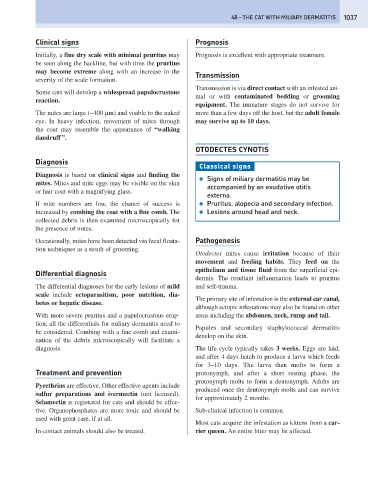Page 1045 - Problem-Based Feline Medicine
P. 1045
48 – THE CAT WITH MILIARY DERMATITIS 1037
Clinical signs Prognosis
Initially, a fine dry scale with minimal pruritus may Prognosis is excellent with appropriate treatment.
be seen along the backline, but with time the pruritus
may become extreme along with an increase in the Transmission
severity of the scale formation.
Transmission is via direct contact with an infested ani-
Some cats will develop a widespread papulocrustous
mal or with contaminated bedding or grooming
reaction.
equipment. The immature stages do not survive for
The mites are large (~400 μm) and visible to the naked more than a few days off the host, but the adult female
eye. In heavy infection, movement of mites through may survive up to 10 days.
the coat may resemble the appearance of “walking
dandruff ”.
OTODECTES CYNOTIS
Diagnosis
Classical signs
Diagnosis is based on clinical signs and finding the
● Signs of miliary dermatitis may be
mites. Mites and mite eggs may be visible on the skin
accompanied by an exudative otitis
or hair coat with a magnifying glass.
externa.
If mite numbers are low, the chance of success is ● Pruritus, alopecia and secondary infection.
increased by combing the coat with a fine comb. The ● Lesions around head and neck.
collected debris is then examined microscopically for
the presence of mites.
Occasionally, mites have been detected via fecal floata- Pathogenesis
tion techniques as a result of grooming.
Otodectes mites cause irritation because of their
movement and feeding habits. They feed on the
epithelium and tissue fluid from the superficial epi-
Differential diagnosis
dermis. The resultant inflammation leads to pruritus
The differential diagnoses for the early lesions of mild and self-trauma.
scale include ectoparasitism, poor nutrition, dia-
The primary site of infestation is the external ear canal,
betes or hepatic disease.
although ectopic infestations may also be found on other
With more severe pruritus and a papulocrustous erup- areas including the abdomen, neck, rump and tail.
tion, all the differentials for miliary dermatitis need to
Papules and secondary staphylococcal dermatitis
be considered. Combing with a fine comb and exami-
develop on the skin.
nation of the debris microscopically will facilitate a
diagnosis. The life cycle typically takes 3 weeks. Eggs are laid,
and after 4 days hatch to produce a larva which feeds
for 3–10 days. The larva then molts to form a
Treatment and prevention protonymph, and after a short resting phase, the
protonymph molts to form a deutonymph. Adults are
Pyrethrins are effective. Other effective agents include
produced once the deutonymph molts and can survive
sulfur preparations and ivermectin (not licensed).
for approximately 2 months.
Selamectin is registered for cats and should be effec-
tive. Organophosphates are more toxic and should be Sub-clinical infection is common.
used with great care, if at all.
Most cats acquire the infestation as kittens from a car-
In-contact animals should also be treated. rier queen. An entire litter may be affected.

